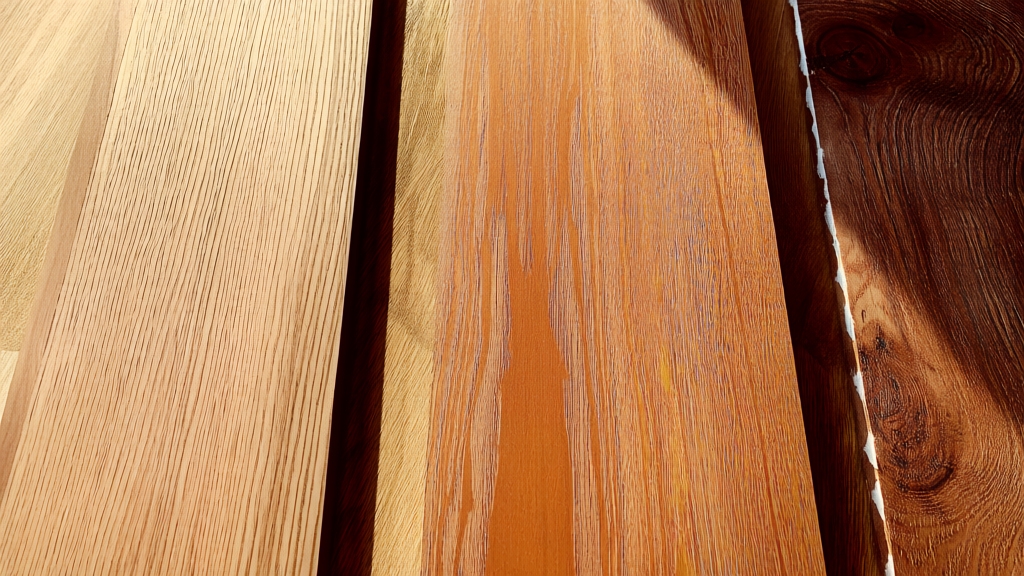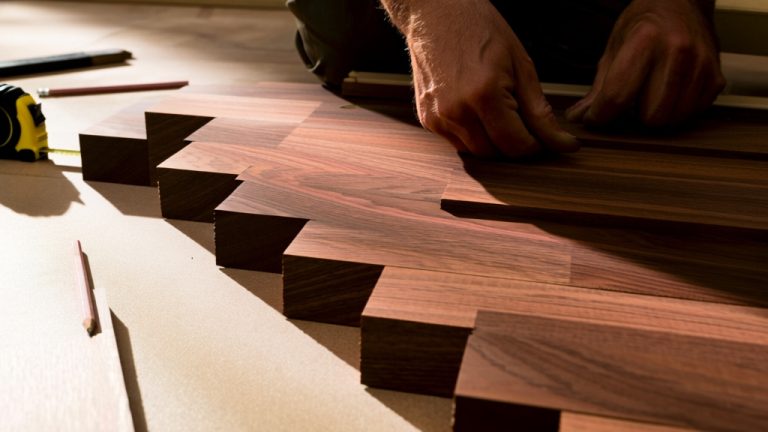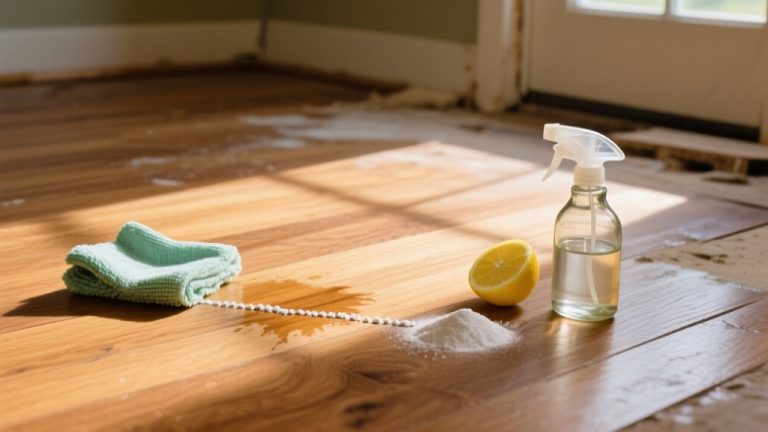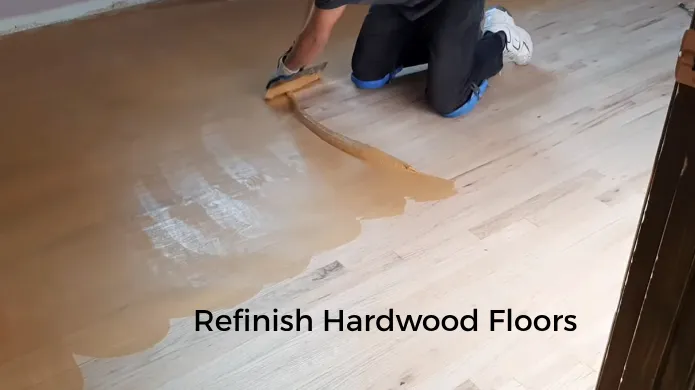How to Tell What Type of Hardwood Floor You Have?
You can tell your hardwood floor type by examining the grain pattern and color. Oak shows open grain with reddish or grayish tones. Maple is smooth and creamy. Walnut features dark heartwood with straight grain.
Check the plank thickness and edges to differentiate solid, engineered, or laminate floors. Assess hardness and density through physical tests, noting moisture sensitivity and installation style.
Properly identifying these features guarantees accurate classification and care. Explore further to enhance your understanding of hardwood flooring nuances.
Key Takeaways
- Examine the grain pattern: oak has open, coarse grains; maple shows fine, straight grains; walnut features mostly straight with occasional burls.
- Assess color tones: red oak is reddish-brown, white oak grayish-brown, maple creamy white, and walnut dark brown to purplish.
- Check plank thickness and edges: solid hardwood is thicker (~¾ inch) with beveled, irregular edges, while engineered hardwood has thinner veneer layers.
- Perform a hardness test or compare density; harder woods like Brazilian walnut resist dents more than softer species like red oak.
- Observe moisture response: solid hardwood warps or swells with water, laminate resists moisture, and vinyl flooring remains unaffected.
Visual Characteristics of Common Hardwood Species
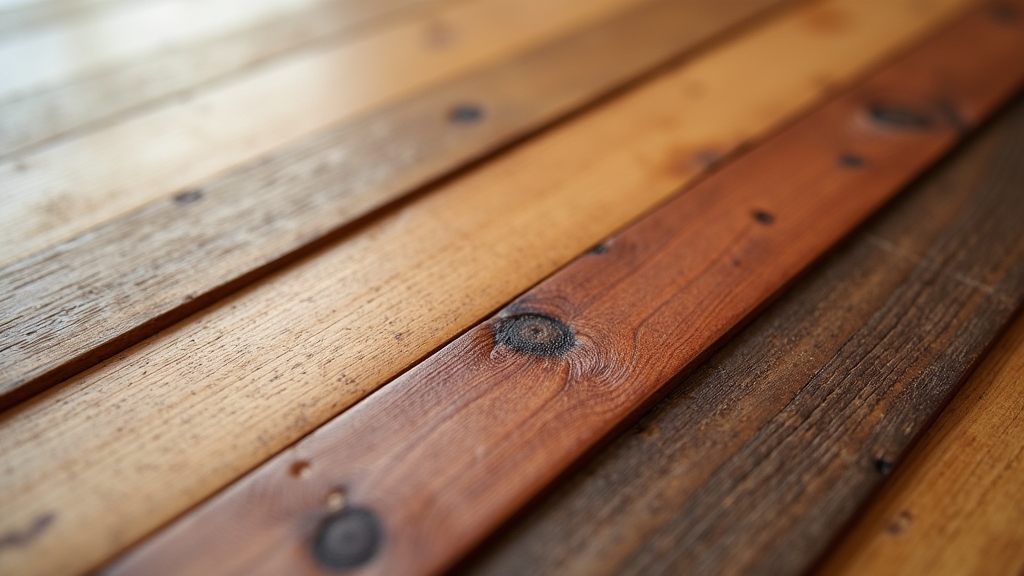
When identifying common hardwood floor types, you’ll want to focus on key visual traits such as color, grain pattern, and texture, which vary considerably among species.
Oak, both red and white, shows open grain with coarse texture. Red oak has reddish-brown heartwood, while white oak features grayish-brown tones. Oak has two varieties: red oak (more color variation) and white oak (more uniform) which helps in distinguishing between them.
Maple offers a smooth, dense surface with fine, straight grain, often creamy white and sometimes patterned like curly or bird’s eye.
Walnut exhibits dark brown to purplish heartwood contrasted by light sapwood, with mostly straight grain and occasional burls.
Hickory stands out with high-contrast reddish-brown heartwood and creamy sapwood, plus a rugged grain texture.
Exotic hardwoods like mahogany and teak display rich, deep colors and fine to coarse grains, with teak’s oily texture providing natural sheen. Exotic woods generally have more character marks and darker, richer colors.
Physical Testing Methods for Hardwood Identification
When it comes to identifying hardwood types, one of the first things you can do is check their density and weight. You’d be surprised at how much these factors can differ from one species to another, and they really play a role in how durable the wood is.
Hardwoods are generally denser and more durable due to their complex cell structures. Using a hardness test can give you a more precise idea of the wood’s durability and type.
Another useful method is to conduct hardness and texture tests. For example, you might apply some controlled pressure to see how the wood responds or take a closer look at its surface resistance. This can help you tell apart the harder woods from the softer ones pretty effectively.
Density and Weight
Although visual inspection provides clues, accurately identifying hardwood floor types often depends on measuring density and weight. To do this, cut a small sample from an inconspicuous area, then measure its length, width, and thickness precisely to calculate volume.
Weigh the sample using a kitchen scale or precision balance, preferably after oven-drying at about 105°C to remove moisture, ensuring consistent weight. Calculate density by dividing the mass by volume, expressed in g/cm³ or kg/m³.
You can then compare this value to reference charts to narrow down species. Specific gravity, the ratio of wood density to water density, also aids differentiation, especially between similar-looking hardwoods and softwoods.
Because hardwoods are heavier, measuring weight and density provides a reliable way to distinguish between hardwood species and softer woods.
This method provides objective data that complements visual analysis, improving your accuracy in identifying hardwood floor types. For best results, ensure you follow proper maintenance and cleaning practices to preserve the wood’s integrity during testing.
Hardness and Texture
Since density and weight provide foundational data, evaluating hardness and texture offers critical physical insights that further refine hardwood identification.
The Janka hardness test quantifies a species’ resistance to denting by embedding a 0.444” steel ball halfway into a wood sample, yielding results in pounds-force. This standardized measure helps you compare durability across species.
The force required for embedding is recorded and expressed in various units depending on country, which is important to consider when comparing international data on wood hardness measurement units.
Understanding the polyurethane adhesive often used in engineered hardwood floors can also inform how wear and maintenance impact surface hardness over time.
Northern Red Oak rates about 1290 lbf, while Brazilian Walnut reaches 3580 lbf. Remember, hardness varies with grain direction, affecting wear resistance.
Texture, encompassing surface feel and grain pattern, also aids identification. It ranges from smooth to coarse depending on species. Proper care and removal techniques for hardwood can influence how texture changes after installation or during replacement.
Differences Between Solid, Engineered, and Laminate Flooring
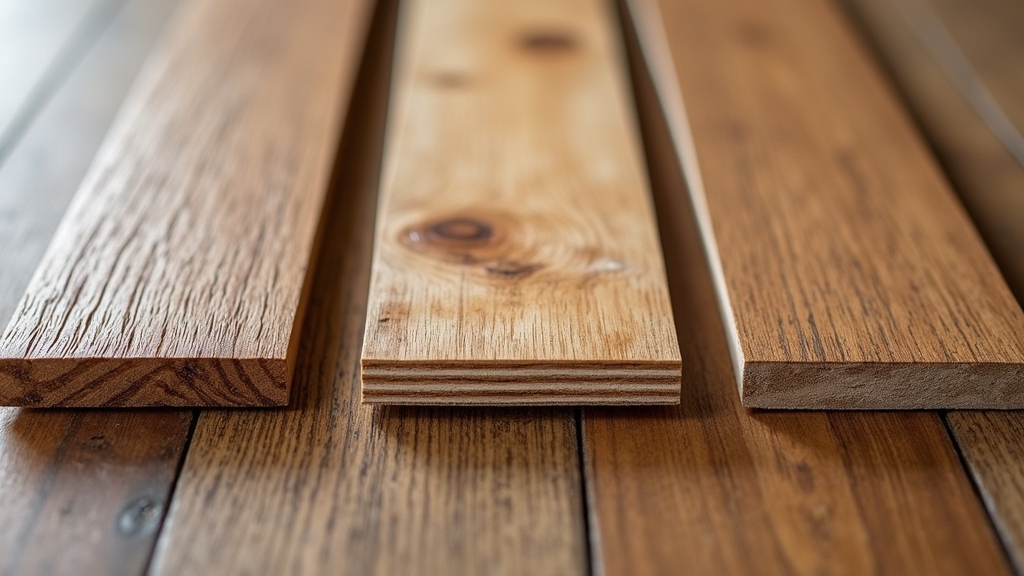
When it comes to flooring options, solid hardwood is a top choice for many. It’s made from a single piece of wood, which means it’s incredibly durable.
However, keep in mind that it requires nail-down installation and you have to be pretty careful about moisture levels in your home. Solid hardwood is generally limited to above-grade, dry areas because of its sensitivity to humidity.
On the other hand, engineered hardwood is a bit different. It combines a real wood veneer with a plywood core. This design gives you more flexibility in installation methods and it’s better at resisting moisture.
Because of its layered construction, engineered hardwood is suitable for installation in areas with higher moisture or even below-grade spaces. So, if you’re looking for something a little more adaptable, engineered hardwood might just be the way to go.
Now, let’s talk about laminate flooring. It’s constructed from a fiberboard core topped with a photographic layer that mimics wood. This makes it a more budget-friendly option, and it’s quite durable too.
However, one downside is that it doesn’t have the same refinishing options as solid or engineered hardwood, plus it lacks the natural qualities that come with real wood.
Construction Methods Comparison
When choosing between solid, engineered, and laminate flooring, understanding their core construction is essential because it directly affects durability, installation, and performance.
Solid hardwood consists of a single, solid wood piece, exhibiting natural grain throughout. Engineered hardwood uses a real wood veneer over multiple plywood layers, enhancing dimensional stability.
Engineered hardwood is more environmentally friendly than solid hardwood, as it uses fewer natural resources, making it a sustainable choice for eco-conscious consumers.
Laminate flooring features a fiberboard core topped with a photographic wood-look layer and a protective clear coat, containing no real wood. Proper maintenance and cleaning techniques are crucial to preserving the appearance and longevity of laminate floors, especially when dealing with abrasive particles like diatomaceous earth.
Solid wood naturally expands and contracts with humidity, while engineered hardwood’s layered core minimizes this effect. Laminate resists moisture well due to its sealed synthetic core but can swell if water penetrates seams.
Each construction method determines your floor’s behavior in different environments and influences aesthetic authenticity, refinishability, and suitability for varied installation scenarios.
Installation and Durability
Although all three hardwood floor types offer unique benefits, their installation methods and durability vary considerably. This influences your choice based on project requirements and environmental conditions. Here’s what you need to know:
- Solid hardwood requires nail-down installation on moisture-controlled wooden subfloors. It offers exceptional longevity with multiple refinishes. This type generally has a higher cost per square foot due to its durability and quality.
- Engineered hardwood provides versatile installation options: floating, nail-down, or glue-down. It also has improved moisture resistance, though refinishing is limited. Additionally, engineered hardwood features a top veneer of real wood protected by a clear acrylic coating that enhances durability.
- Laminate installs quickly as a floating floor using click-lock systems. It has superior surface water resistance but no refinishing option. This makes laminate a cost-effective choice compared to refinishing hardwood floors.
- In terms of durability, solid hardwood excels in lifespan but is moisture-sensitive. Engineered hardwood balances stability and moderate moisture resistance. Laminate resists scratches well but is vulnerable if water infiltrates edges.
Choose based on your subfloor, moisture exposure, and maintenance willingness for ideal performance and lifespan.
How to Distinguish Hardwood Floors From Vinyl Flooring
Distinguishing hardwood floors from vinyl flooring involves examining key visual and textural characteristics.
Hardwood exhibits natural grain variations and subtle imperfections unique to each plank. Regular maintenance and cleaning help preserve the natural beauty and prevent scratch formation on hardwood surfaces.
Vinyl mimics these patterns with uniform, often repeating designs lacking depth.
Underfoot, hardwood feels textured and warm; vinyl is smoother and cooler.
Inspect plank edges: hardwood typically has beveled, irregular edges.
Vinyl edges are uniform and flush.
Consider moisture response: hardwood warps or swells with water exposure.
Vinyl resists moisture without damage, making it a popular choice for areas prone to spills or humidity due to its moisture resistance.
Hardwood dents and scratches more easily, but these can be sanded out.
Vinyl resists dents but may show surface scrapes and requires replacement if damaged.
Finally, hardwood planks are thicker (around ¾ inch) and attached by nails or glue.
Vinyl is thinner and installed with click-lock or adhesive methods.
Identifying Wood by Grain Patterns and Color Variations
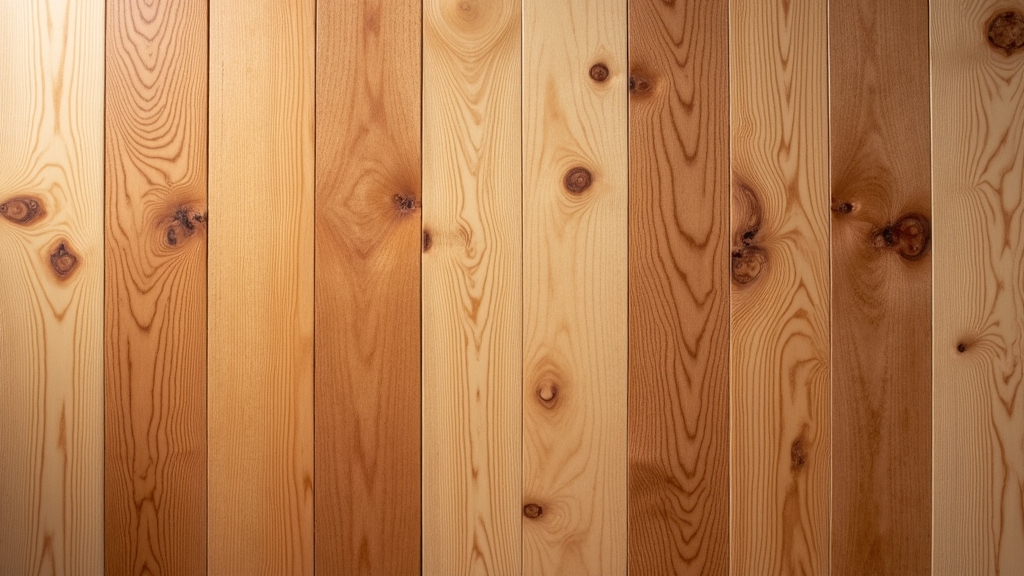
Because grain patterns and color variations reveal much about hardwood species, you can identify wood types by closely examining these features.
Start by observing the grain type: cathedral grains with arched patterns often indicate plain sawn wood, while straight, linear grains suggest quarter or rift sawn cuts. The way logs are cut during milling directly determines the resulting grain pattern appearance, making the sawing method a key factor in identification log sawing methods.
Properly preparing and cleaning the wood surface can also enhance visibility of these grain details before inspection. Next, note the color tone—red oak has warm reddish-brown hues with visible variation; maple is creamy with minimal disparity.
Then, consider texture and pore structure: open grains like oak have coarse, large pores; closed grains like cherry are finer and tighter. Applying a fire retardant product can sometimes alter the appearance and texture, which is important to recognize when identifying treated hardwood floors.
Finally, evaluate color depth and changes over time, such as cherry darkening to a rich red-brown, or exotic woods showing dramatic, intricate variations.
This methodical approach guarantees accurate hardwood identification.
Steps to Identify Hardwood by Grain and Color:
- Examine grain pattern type (cathedral, linear, swirl)
- Observe color tone and variation
- Assess texture and pore structure
- Consider color changes and exotic wood traits
Using Regional and Historical Context in Hardwood Identification
When identifying hardwood floors, factoring in regional and historical context sharpens your accuracy considerably.
For instance, if your floor is in the eastern U.S., oak likely dominates due to its historical prevalence, especially in states like Pennsylvania or Missouri.
In the American South, heart pine is a common original material, reflecting local timber availability. Proper maintenance is important because certain wood types can be vulnerable to damage from moisture and stains.
European homes from the Georgian era often use wide oak planks, while Edwardian-era floors may feature imported teak in parquet patterns. Recognising period-specific features such as plank width and joinery types can also help pinpoint the floor’s age and origin.
Transportation advances expanded species distribution, so consider trade routes when exotic woods appear outside their native regions.
Reviewing local archives or historical building permits can also confirm species used during construction. Understanding the wood’s susceptibility to substances like pet urine can aid in preservation efforts.
Practical Tips for Verifying Your Hardwood Floor Type
Understanding the historical and regional contexts of your hardwood floor guides you toward likely species and styles, but confirming its exact type requires hands-on examination.
You’ll need to analyze grain patterns, hardness, board construction, and moisture response directly.
- Inspect the grain depth and color variation; hardwoods have pronounced pores and diverse hues, unlike softwoods or laminates with uniform patterns. Look for unique grain patterns with subtle variations in direction and natural imperfections that add character.
- Conduct a scratch or dent test to gauge density and hardness; hardwoods resist marks better and show consistent color beneath the surface. Proper drying is essential to maintain the integrity of the wood after any moisture testing.
- Measure board thickness and examine edges; solid hardwood is about 3/4 inch thick with natural layering, while engineered or synthetic boards differ.
- Apply a water droplet test cautiously; real wood absorbs moisture temporarily, whereas synthetic floors resist or warp. Avoid excessive water use during testing to prevent potential moisture penetration and damage.
These steps ensure precise hardwood identification.
Frequently Asked Questions
Can Hardwood Floors Be Refinished Multiple Times Without Damage?
You can refinish hardwood floors multiple times, but it depends on the wood type and wear layer thickness. Solid hardwood floors typically handle 5 to 10 refinishing cycles, thanks to their thick composition.
Engineered hardwood floors vary; some allow one or two refinishes, while others only support recoating.
Always test the wear layer thickness before sanding to avoid damaging or sanding through the floor, which could cause irreversible harm and require replacement.
How Does Humidity Affect Hardwood Floor Stability and Lifespan?
Think of your hardwood floor as a living creature breathing with the air. Humidity makes it expand and contract. When moisture spikes, your floor swells, risking cupping or buckling. During dry spells, it shrinks, causing gaps.
These fluctuations shorten its lifespan by stressing wood fibers. Solid hardwood reacts more dramatically than engineered types.
To keep stability and durability, maintain indoor humidity between 35-55% and acclimate your flooring properly before installation.
What Are the Environmental Impacts of Different Hardwood Species?
You’ll find that different hardwood species vary in environmental impact mainly by their carbon footprint, growth rate, and processing needs.
For example, black cherry has a lower cradle-to-gate carbon footprint and faster growth, making it more sustainable than denser woods like oak.
Also, how the wood is harvested, processed, and disposed of affects emissions. Choosing fast-growing species and responsibly sourced wood reduces your environmental impact markedly.
Are There Specific Hardwoods Better Suited for Radiant Floor Heating?
Just like choosing the right armor for a battle, you want hardwoods that stand strong under radiant heat.
Oak and hickory top the list with excellent durability and dimensional stability, ensuring your floors won’t warp or buckle.
Engineered hardwoods with a 3/8″ to 1/2″ thickness and a 2–4 mm wear layer perform best, balancing heat transfer and longevity.
Avoid softer woods unless engineered properly, and control temperatures below 85°F to protect your investment.
How to Identify if Hardwood Flooring Contains Any Toxic Finishes or Treatments?
You can identify toxic finishes by conducting tests like water drop, scrape, and solvent tests to determine finish type. Check for off-gassing odors or prolonged chemical smells, indicating VOC emissions.
Review product labels or manufacturer info for preservatives or chemicals like formaldehyde or NMP. Older floors may contain unsafe treatments not meeting current standards.
Using a VOC meter or professional air quality test helps detect hazardous emissions from finishes or treatments effectively.
Preserve Your Home’s Prestige Through Proper Floor Insight
By blending visual verification, physical probing, and pattern perception, you’ll confidently classify your hardwood floor type. Remember, recognizing regional roots and historical hints heightens your hardwood horizon.
Whether solid, engineered, or laminate, your floor’s fiber tells a factual story. Don’t disregard details; distinct differences demand deliberate discernment. With these practical pointers, you’re perfectly poised to pinpoint your floor’s precise profile, preventing pricey mistakes and preserving your property’s polished prestige.

